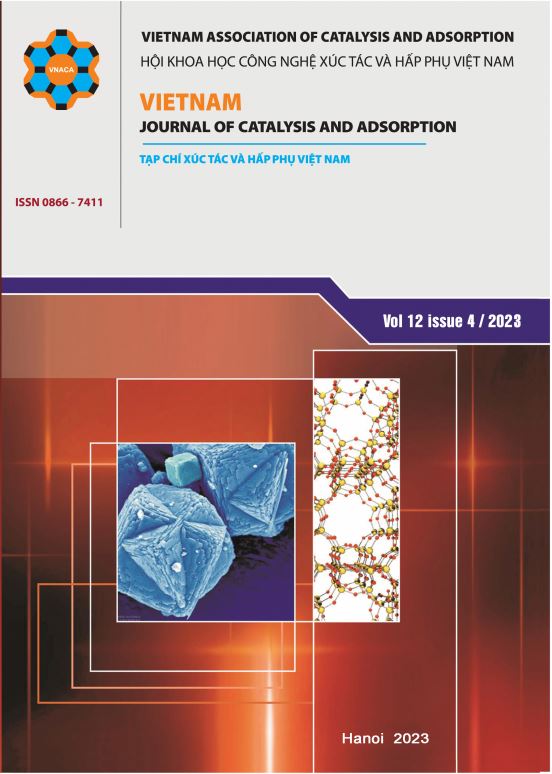Research on column adsorption of Zn2+ by hydroxyapatite granules
DOI:
https://doi.org/10.62239/jca.2023.076Keywords:
hydroxyapatite granule, adsorption, removal of Zn2+ionsAbstract
Hydroxyapatite (HAp) granules were fabricated successfully from HAp powder and polyvinyl alcohol (PVA) additive by sintering method. The characterization of material was analyzed by color, durability in the water, XRD, EDX, SEM and BET. The obtained HAp granules were white, single phase of HAp, with specific surface area of 73 m2/g, size of granule about (2 × 10) mm. HAp granules were used for the removal of Zn2+ ions from aqueous solution. The effect of factors on the Zn2+ adsorption property was investigated. The adsorption efficiency and capacity obtained 77.15 % and 2.57 mg/g, respectively at suitable batch adsorption condition: HAp granule mass of 0.5 g/ 50mL solution, initial concentration of 20 mg/L Zn2+, contact time 40 minutes and pH0 5.7 at 30 oC. The adsorption efficiency reached about 99.55 % at suitable column adsorption condition: contact time of 3,5 min, flow rate of 14 mL/min, adsorption zone height of 4Ф (Ф = 2.5 cm), initial concentration of 20 mg/L Zn2+, HAp granule mass of 11.9 g/ 2L solution, pH0 5.7 at 30 oC.
Downloads
References
Fu, F. and Wang, Q., J. Environ. Manage. 92(3) (2011) 407–418. http//doi.ofg/10.1016/j.jenvman.2010.11.011
Phạm luận, Vai trò của muối khoáng và nguyên tố vi lượng đối với sự sống của con người, Trường Đại học Khoa học Tự nhiên, Đại học Quốc gia Hà Nội, 1998.
Sheha, R.R., Journal of Colloid and Interface Science, Vol. 310(1) (2007) 18-26. https://doi.org/10.1016/j.jcis.2007.01.047
Sumathi, S.B.G., Ceramics International 40(10, Part A) (2014) 15655-15662. https://doi.org/10.1016/j.ceramint.2014.07.086
Krylova, E.A., et al., Hydroxyapatite-Alginate Sructure as Living Cells Supporting System, Institute of Biochemical Physics RAS, Russia.
Kasioptas, A.P.C., et al., Mineralogical Magazine 72(1) (2008) 77-80. https://doi.org/10.1180/minmag.2008.072.1.77
Tim, V.C., Porous Scaffolds for the Replacement of Large Bone Defects: a Biomechanical Design Study, PhD thesis, KU. Leuven – Belgium, 2005.
Flávio, A.C.A., et al., Ceramics International 42 (2016) 2271–2280. https://doi.org/10.1016/j.ceramint.2015.10.021
Guangfei, S., et al., Materials Science and Engineering: C 39 (2014) 67-72. https://doi.org/10.1016/j.msec.2014.02.023
Neha, G., et al., Journal of the Taiwan Institute of Chemical Engineers 43(1) (2012) 125-131. https://doi.org/10.1016/j.jtice.2011.07.009
Ronghai, Z., et al., Catalysis Today 139(1-2) (2008) 94-99. https://doi.org/10.1016/j.cattod.2008.08.011
Arunima, N. and Brij, B., Materials today: proceedings 46, Part 20 (2021) 11029-11034. https://doi.org/10.1016/j.matpr.2021.02.149
Mousa, S.M., et al., Journal of Saudi Chemical Society 20 (2016) 357-365. https://doi.org/10.1016/j.jscs.2014.12.006
Nirav, P.R., et al., Journal of Environmental Management 179 (2016) 1-20. https://doi.org/10.1016/j.jenvman.2016.04.045
Armin, V., et al., Environmental Nanotechnology, Monitoring & Management 12 (2019) 100233. https://doi.org/10.1016/j.enmm.2019.100233
Doaa, A.E., et al., Arabian Journal of Chemistry 13(11) (2020) 7695-7706. https://doi.org/10.1016/j.arabjc.2020.09.005
Andrew, N.A., et al., Journal of Environmental Management 302, Part A (2022) 113989. https://doi.org/10.1016/j.jenvman.2021.11398917
Mobasherpour, I., et al., Arabian Journal of Chemistry 5(4) (2012) 439-446. https://doi.org/10.1016/j.arabjc.2010.12.022
Wei, W., et al., Desalination 263(1-3) (2010) 89-96. https://doi.org/10.1016/j.desal.2010.06.043
Deyi, Z., et al., Journal of Hazardous Materials 241-242 (2012) 418-426. https://doi.org/10.1016/j.jhazmat.2012.09.066
Bahdod, A., et al., Water research 43 (2009) 313-318. https://doi.org/10.1016/j.watres.2008.10.023
Huijuan, H., et al., Chemical Engineering Journal 211-212 (2012) 336-342. https://doi.org/10.1016/j.cej.2012.09.100
Sanna, H., et al., Chemical Engineering Journal 252 (2014) 64-74. https://doi.org/10.1016/j.cej.2014.04.101
Kai, H.Z., et al., Materials Science and Engineering C 30 (2010) 283–287. https://doi.org/10.1016/j.msec.2009.11.003
Veljovic´ Dj., et al., Ceramics International 36 (2010) 595–603. https://doi.org/10.1016/j.ceramint.2009.09.038
Dean-MO, L., Ceramics International 24 (1998) 441-446. https://doi.org/10.1016/S0272-8842(97)00033-3
Janis, L., et al., Journal of the European Ceramic Society 33 (2013) 3437–3443. https://doi.org/10.1016/j.jeurceramsoc.2013.06.010
Duyen, T.L., et al., Journal of Chemistry 2019, Article ID 8620181 (2019) 10 pages. https://doi.org/10.1155/2019/8620181
Phương, T.N., et al., Tạp chí Khoa học & Công nghệ 50(3E) (2012) 1220-1227.
Hieu, M.T.D., et al., Journal of Environmental Science and Engineering B 5 (2016) 371-378. https://doi:10.17265/2162-5263/2016.07.008











